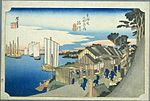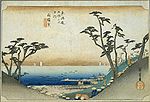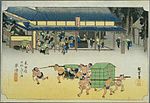The Fifty-three Stations of the Tōkaidō
Appearance
This article may have too many red links. (April 2021) |

The Fifty-Three Stations of the Tōkaidō (東海道五十三次, Tōkaidō Gojūsan-tsugi) is a series of ukiyo-e woodblock prints created by Hiroshige.[1] This was a popular subject. Hiroshige created many versions of this subject.
Tōkaidō images
[change | change source]In 1832, Hiroshige traveled the length of the Tōkaidō from Edo to Kyoto. He was part of an official delegation from the court of the Tokugawa Shogunate to the court of the Emperor of Japan.[2]
In addition to the 53 stations, Hiroshige's series of images includes one print showing the departure from Edo. The series also includes a print showing the journey's end in the Imperial capital city.
| № | Woodcut print | Station No and English name | Japanese | Transliteration |
|---|---|---|---|---|
 |
Leaving Edo : Nihonbashi Bridge, "the bridge of Japan" | 日本橋 | Nihonbashi | |
| 1 |  |
1st station : Shinagawa. | 品川 | Shinagawa |
| 2 |  |
2nd station : Kawasaki | 川崎 | Kawasaki |
| 3 |  |
3rd station : Kanagawa | 神奈川 | Kanagawa |
| 4 |  |
4th station : Hodogaya | 程ヶ谷, 保土ヶ谷 | Hodogaya |
| 5 |  |
5th station : Totsuka | 戸塚 | Totsuka |
| 6 |  |
6th station : Fujisawa | 藤沢 | Fujisawa |
| 7 |  |
7th station : Hiratsuka | 平塚 | Hiratsuka |
| 8 |  |
8th station : Oiso | 大磯 | Oiso |
| 9 |  |
9th station : Odawara (Crossing the Sakawa river at a ford.) | 小田原 | Odawara |
| 10 |  |
10th station : Hakone | 箱根 | Hakone |
| 11 |  |
11th station : Mishima | 三島 | Mishima |
| 12 |  |
12th station : Numazu | 沼津 | Numazu |
| 13 |  |
13th station : Hara | 原 | Hara |
| 14 |  |
14th station : Yoshiwara | 吉原 | Yoshiwara |
| 15 |  |
15th station : Kambara | 蒲原 | Kanbara |
| 16 |  |
16th station : Yui | 由井, 由比 | Yui |
| 17 |  |
17th station : Okitsu | 興津 | Okitsu |
| 18 |  |
18th station : Ejiri | 江尻 | Ejiri |
| 19 |  |
19th station : Fuchū | 府中, 駿府 | Fuchū |
| 20 |  |
20th station : Mariko | 鞠子, 丸子 | Mariko |
| 21 |  |
21st station : Okabe | 岡部 | Okabe |
| 22 |  |
22nd station : Fujieda | 藤枝 | Fujieda |
| 23 |  |
23rd station : Shimada | 島田 | Shimada |
| 24 |  |
24th station : Kanaya | 金屋, 金谷 | Kanaya |
| 25 |  |
25th station : Nissaka | 日坂 | Nissaka |
| 26 |  |
26th station : Kagegawa | 掛川 | Kagegawa |
| 27 |  |
27th station : Fukuroi | 袋井 | Fukuroi |
| 28 |  |
28th station : Mitsuke | 見附 | Mitsuke |
| 29 |  |
29th station : Hamamatsu | 浜松 | Hamamatsu |
| 30 |  |
30th station : Maisaka | 舞阪 | Maisaka |
| 31 |  |
31st station : Arai | 荒井, 新居 | Arai |
| 32 |  |
32nd station : Shirasuka | 白須賀 | Shirasuka |
| 33 |  |
33rd station : Futagawa | 二川 | Futagawa |
| 34 |  |
34th station : Yoshida | 吉田 | Yoshida |
| 35 |  |
35th station : Goyu | 御油 | Goyu |
| 36 |  |
36th station : Akasaka | 赤坂 | Akasaka |
| 37 |  |
37th station : Fujikawa | 藤川 | Fujikawa |
| 38 |  |
38th station : Okazaki | 岡崎 | Okazaki |
| 39 |  |
39th station : Chiryu | 地鯉鮒, 知立 | Chiryu |
| 40 |  |
40th station : Narumi | 鳴海 | Narumi |
| 41 |  |
41st station : Miya | 宮 | Miya |
| 42 |  |
42nd station : Kuwana | 桑名 | Kuwana |
| 43 |  |
43rd station : Yokkaichi | 四日市 | Yokkaichi |
| 44 |  |
44th station : Ishiyakushi | 石薬師 | Ishiyakushi |
| 45 |  |
45th station : Shōno | 庄野 | Shōno |
| 46 |  |
46th station : Kameyama | 亀山 | Kameyama |
| 47 |  |
47th station : Seki "the barrier" | 関 | Seki |
| 48 |  |
48th station : Sakanoshita | 坂ノ下 | Sakanoshita |
| 49 |  |
49th station : Tsuchiyama | 土山 | Tsuchiyama |
| 50 |  |
50th station : Minakuchi | 水口 | Minakuchi |
| 51 |  |
51st station : Ishibe | 石部 | Ishibe |
| 52 |  |
52nd station : Kusatsu | 草津 | Kusatsu |
| 53 |  |
53rd station : Ōtsu | 大津 | Ōtsu |
 |
The end of the Tōkaidō: arriving at Kyoto. | 京師 | Sanjō Ōhashi Bridge at Keishi ("the capital") |
Related pages
[change | change source]References
[change | change source]- ↑ Nussbaum, Louis-Frédéric. (2005). "Tōkaidō Gojūsan tsugi" in Japan Encyclopedia, p. 973.
- ↑ Oka, Isaburō. (1997). Hiroshige: Japan's Great Landscape Artist, p. 75.
Other websites
[change | change source]Wikimedia Commons has media related to The Fifty-three Stations of the Tōkaidō.
